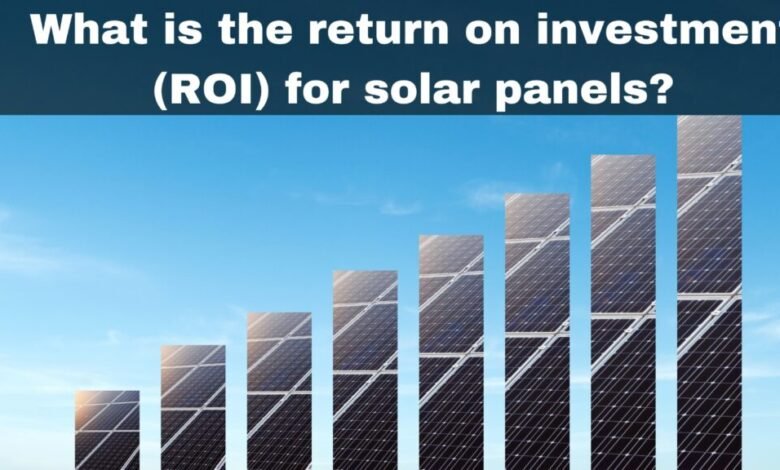Return on Investment (ROI) for Home Solar Systems

As residential solar energy adoption grows, homeowners are increasingly concerned about one key factor: Return on Investment (ROI). Going solar isn’t just about saving the planet—it’s about saving money, too. With falling installation costs, rising electricity rates, and generous government incentives, solar energy is no longer a luxury—it’s a financially smart move.
This guide breaks down how ROI works for home solar systems, the key variables affecting it, how to calculate it, and whether solar is worth the investment in 2025 and beyond.
What Is ROI in the Context of Home Solar?
ROI, or Return on Investment, is a measure of how much financial benefit you get from a particular investment—in this case, a residential solar power system. It’s expressed as a percentage and helps you understand how long it will take to recoup your upfront solar installation cost through savings on your energy bills.
A high ROI means your system pays for itself relatively quickly and continues to generate savings over its lifespan, often 25+ years. Click here for our solceller på tag guide
Key Components That Influence Solar ROI
1. Initial Installation Cost
The upfront cost of installing solar panels includes:
- Solar panels and inverters
- Mounting equipment
- Labor/installation charges
- Permit and inspection fees
- Optional battery storage systems
In 2025, the average installation cost for a home solar system is between $10,000 to $20,000 after federal tax credits, depending on location and system size.
2. Electricity Rates in Your Area
Higher local electricity prices = higher savings potential.
For example, if you’re paying $0.25 per kWh in California vs. $0.10 per kWh in Texas, your ROI will likely be much faster in California.
3. Energy Usage and Solar System Size
Larger energy consumption means a bigger solar system, which:
- Costs more upfront
- Provides more savings over time
If your system meets 100% of your energy needs, your monthly utility bills may drop to near zero, accelerating ROI.
4. Incentives, Tax Credits, and Rebates
In 2025, you can take advantage of:
- Federal Solar Tax Credit (ITC): 30% credit on your system cost
- State and Local Rebates
- Net Metering Policies: Sell excess electricity back to the grid
These incentives can reduce your payback period by 3–5 years in some cases.
5. Solar Panel Efficiency and Lifespan
Modern solar panels have an average lifespan of 25–30 years, with most still operating at 80–90% capacity even after 25 years. High-efficiency panels can deliver better ROI by producing more energy with less roof space.
How to Calculate Solar ROI (with Formula)
Here’s a simple way to calculate your solar ROI:
ROI (%) = (Net Savings / Total Cost) × 100
Where:
- Net Savings = Total savings over system lifespan (25 years)
- Total Cost = Upfront installation cost – any tax credits or rebates
Example:
- Installation cost: $18,000
- Federal Tax Credit (30%): $5,400
- Net Cost = $12,600
- Annual electricity savings: $1,200
- 25-year savings = $1,200 × 25 = $30,000
ROI = ($30,000 – $12,600) / $12,600 × 100 = 138%
This means you’re getting back 138% more than what you invested—making solar an excellent long-term financial move.
Payback Period: When Will You Break Even?
The payback period is the time it takes to recover your initial investment. Here’s the formula:
Payback Period = Net System Cost / Annual Savings
Using the same example above:
Payback Period = $12,600 / $1,200 = 10.5 years
After 10.5 years, your system has paid for itself—and you continue to generate free energy for another 15–20 years.
Solar ROI by Country (2025 Update)
| Country | Avg. Installation Cost (Post Incentives) | Avg. Payback Period | Estimated ROI (%) |
| USA | $12,000 – $18,000 | 8–12 years | 120%–150% |
| Australia | $6,000 – $10,000 | 5–8 years | 150%–200% |
| Germany | €8,000 – €12,000 | 10–14 years | 100%–140% |
| Pakistan | PKR 800,000 – 1,200,000 | 4–6 years | 160%–220% |
| UK | £8,000 – £12,000 | 10–13 years | 100%–130% |
Note: ROI depends on local electricity costs, sunlight availability, and government policies.
Hidden Savings That Boost ROI
1. Increased Property Value
Studies show that homes with solar panels sell 4%–6% higher than similar non-solar homes. If your home is worth $300,000, you could gain $12,000–$18,000 in value just by going solar.
2. Protection Against Rising Electricity Rates
Utility rates rise annually due to inflation and demand. Solar locks in your electricity price, offering decades of predictable savings.
3. Energy Independence and Battery Storage
Installing a solar battery like the Tesla Powerwall from solee gives you backup power during blackouts, making your system more valuable in areas with unreliable grids.
Factors That Can Lower ROI
Despite the benefits, several factors can lower your solar ROI:
- Poor sun exposure (e.g., shaded roofs or bad orientation)
- Low local electricity prices
- Unfavorable net metering laws
- Roof issues that require repair before installation
- Overpriced or oversized systems sold by high-margin installers
To avoid these pitfalls, always get multiple quotes, choose a reputable installer, and conduct a solar feasibility assessment.
Read Also: Air Fryer Myths Busted: Separating Internet Hype from Kitchen Reality
Should You Pay Cash, Finance, or Lease?
Cash Purchase
- Highest ROI
- Shortest payback period
- Full system ownership
Solar Loan
- Good ROI, slightly longer payback
- Monthly payments offset by utility bill savings
Solar Lease or PPA (Power Purchase Agreement)
- Lowest ROI
- No upfront cost, but limited savings
- Installer owns the system
Best ROI Strategy: Buy your solar system outright or through low-interest financing.
Solar ROI vs. Other Investments
How does solar stack up against other common long-term investments?
| Investment | Typical ROI (%) |
| Home Solar System | 100% – 200%+ |
| Stock Market (30 yrs) | ~7% annually |
| Real Estate (rental) | 8% – 12% annually |
| Bank Savings Account | <1% annually |
While solar isn’t liquid like stocks, it provides guaranteed savings and reduces your household expenses every month.
Is Solar Worth It in 2025?
In most cases, yes. Here’s why:
- Installation costs are lower than ever
- Governments are still offering strong incentives
- Electricity prices are rising
- Solar panel efficiency is at an all-time high
- Financing options are more flexible
- Systems last 25–30 years or more
With an ROI of 100% to 200%, few home upgrades pay for themselves as reliably as solar panels.
Conclusion: Maximize ROI with Smart Solar Choices
The return on investment (ROI) for home solar systems continues to improve in 2025 thanks to better technology, declining costs, and supportive policies. While individual results vary by region, usage, and system size, most homeowners see full payback within 6–12 years, followed by decades of free electricity and savings.
To maximize your ROI:
- Shop around and compare multiple quotes
- Use high-efficiency panels with good warranties
- Install before local or federal incentives expire
- Consider battery storage if applicable
- Monitor your system’s performance regularly
Solar isn’t just a sustainable choice—it’s a smart financial decision.
FAQs: ROI for Home Solar Systems
Q1: What is the average ROI for a home solar system?
A: Most homeowners see an ROI between 100% to 200% over 25 years, depending on location, usage, and incentives.
Q2: How long does it take to break even on solar panels?
A: The average payback period is 6–12 years, after which all savings are profit.
Q3: Does solar increase my home’s value?
A: Yes. Homes with solar panels typically sell for 4%–6% more than comparable homes.
Q4: Can I get a loan for a solar system?
A: Yes. Many banks and solar companies offer solar loans with low interest, helping you own your system affordably.
Q5: Are there any risks in going solar?
A: The main risks are poor installation, shaded roofs, or low savings due to mismatched system size. Use certified installers to avoid these issues.




